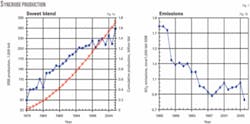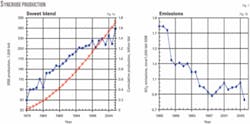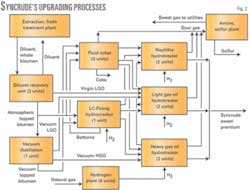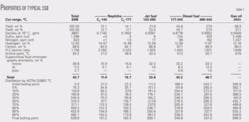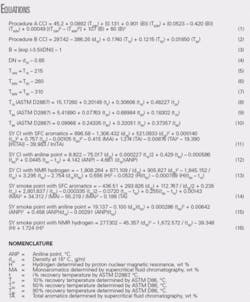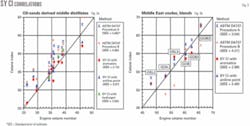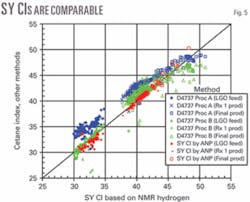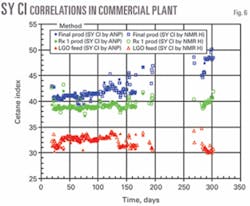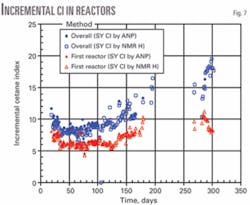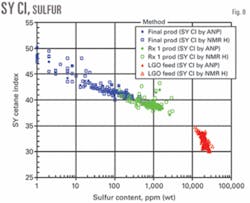As part of the Upgrading Expansion Stage 1 (UE-1) project completed in 2006, Syncrude Canada Ltd. revamped all existing five hydrotreaters and installed an additional diluent recovery unit, a fluid coker, and an aromatics saturation unit for light gas oil. The UE-1 project substantially increased production capacity and improved product quality, such as diesel cetane number and jet fuel smoke point.
This article reviews Syncrude’s operations after the UE-1 revamp and presents a monitoring tool for diesel cetane number and jet fuel smoke point, and its application to the commercial plant.
In the past, Syncrude distilled bitumen in two diluent recovery units and a vacuum distillation unit, and upgraded in two fluid cokers and one ebullating bed hydrocracker, followed by five hydrotreaters.
Syncrude
Syncrude Canada Ltd. is a joint venture owned by seven participants:
- Canadian Oil Sands Ltd., 36.74%.
- ConocoPhillips Oil Sands Partnership II, 9.03%.
- Imperial Oil Resources, 25%.
- Mocal Energy Ltd., 5%.
- Murphy Oil Co. Ltd., 5%.
- Nexen Oil Sands Partnership, 7.23%.
- Petro-Canada Oil & Gas, 12%.
It operates a surface-mining oil sands plant at the Athabasca oil sands deposit in northern Alberta and produces synthetic crude oil from the extracted bitumen. Operations started in 1978 and production has increased to 94 million bbl (258,000 b/d) in 2006 from 28 million bbl (77,000 b/d) in 1979. Cumulative production has exceeded 1.7 billion bbl, while environmental impacts have been substantially reduced.
Fig. 1a illustrates Syncrude production history. The production volume in 2006 was equivalent to 12% of the Canadian crude oil consumption. Fig. 1b illustrates historical SO2 emissions.
The UE-1 project substantially increased production capacity and improved product quality while reducing environmental effects. The new improved-quality product is called Syncrude Sweet Premium (SSP), and the product prior to the UE-1 project was known as Syncrude Sweet Blend (SSB).
The UE-1 project provided facilities to improve of diesel cetane number (CN) and jet fuel smoke point. Syncrude will address the improvement of heavy gas oil (HGO) quality in a future expansion project. Improving the processes for oil sands bitumen recovery and product quality is part of Syncrude’s R&D focus.
In an earlier article (OGJ, Apr. 23, 2001, p. 46), we reviewed Syncrude’s upgrading operations and R&D activities on bitumen chemistry, process improvement, and product-quality improvement.
This article highlights the scope of the UE-1 project in the upgrading area, updates the configuration of the upgrading processes for SSP production, reviews new cetane index (CI) and smoke point correlations suitable for bitumen-derived middle distillates, and discusses how the new CI correlations can be applied to the light gas oil (LGO) streams to monitor the UE-1 processes.
Syncrude’s UE-1 project
Fig. 2 is a simplified flow diagram of Syncrude’s current upgrading process that includes newly installed units completed as part of the UE-1 project in 2006.
Diluent recovery
The diluent recovery unit (DRU) includes three units, the third of which was installed with UE-1 in 2006. Diluted bitumen from the extraction and froth treatment plants is fractionated in the atmospheric DRU. Diluent (heavy naphtha) and some of the virgin LGO contained in the bitumen are recovered.
Diluent returns to the extraction plant and the LGO is routed to the LGO hydrotreater. Part of the atmospheric topped bitumen (ATB) feeds the vacuum distillation unit. The remaining ATB feeds the fluid cokers and LC-Finer hydrocracker.
The nameplate capacity is 330,000 b/d/unit for the earlier two units and 217,000 b/d for the new unit.
Vacuum distillation
The vacuum distillation unit (VDU) further distills ATB into light vacuum gas oil (LVGO), heavy vacuum gas oil (HVGO), and vacuum bottoms (or vacuum topped bitumen, VTB). LVGO and HVGO feed the LGO hydrotreater and HGO hydrotreater, respectively, and VTB feeds the fluid cokers and LC-Finer. The nameplate capacity is 285,000 b/d.
Fluid coker
Syncrude has three fluid cokers; the third was installed with UE-1 in 2006.
The feeds are combined ATB and VTB, and LC-Finer bottoms. The products are sour hydrocarbon gases, liquid products, and coke. The liquid products are fractionated into naphtha, LGO, and HGO.
Naphtha is treated in the naphtha hydrotreater. Before UE-1, LGO and HGO were combined and treated in the HGO hydrotreater; they are now treated in the LGO hydrotreater and HGO hydrotreater, respectively.
The new coker is equipped with a flue gas desulfurization unit to convert sulfur in burner offgas into ammonium sulfate fertilizer as a by-product. The nameplate capacity is 107,000 b/d/unit for the older two units and 95,000 b/d for the new unit.
LC-Finer
The LC-Finer hydrocracker cracks combined ATB and VTB in an ebullating catalyst bed with hydrogen. The total liquid products are fractionated into light naphtha, heavy naphtha, LGO, HGO, and bottoms.
Light naphtha is treated in the naphtha hydrotreater. Heavy naphtha is used as make-up diluent for the upstream froth treatment process. LGO and HGO are treated in the LGO hydrotreater and HGO hydrotreater, respectively. Bottoms are routed to a coker. Nameplate capacity is 50,000 b/d.
Hydrogen plants
There are four hydrogen generation units at Syncrude. The fourth was installed with the UE-1 project in 2005. Hydrogen is produced via steam reforming natural gas.
Hydrotreating
Syncrude had five fixed-bed hydrotreating units before UE-1: two naphtha hydrotreaters, one LGO hydrotreater, and two HGO hydrotreaters. The UE-1 project revamped the five existing units to improve operability and product quality, and added a new LGO hydrotreater for aromatics saturation to substantially improve the diesel cetane number and jet fuel smoke point.
Some key features include:
• Naphtha hydrotreater. There are two identical units in parallel. Each unit has three reactors in series: a diolefin reactor and two main reactors. The diolefin reactor hydrogenates diolefins in the feed (mostly coker naphtha) at a relatively low temperature to prevent polymerization, which can lead to fouling of the catalyst bed at main reactor conditions (OGJ, Sept. 6, 1999, p. 64).
Main reactors reduce the nitrogen content to 1 ppm (wt), so that downstream refiners can use the hydrotreated naphtha in catalytic reformers with noble metal catalysts.
The reactor configuration before UE-1 resulted in gas-liquid mixed phase reactions, thereby causing flow maldistribution and hot spots in the reactors. The UE-1 project eliminated the mixed-phase reactions by splitting the product from the diolefin reactor into light and heavy fractions, and charging them separately into the two main reactors. By doing so, flow maldistribution and hot spots in the reactor are minimized, and catalyst utilization is enhanced.
Nameplate capacity is 48,500 b/d/unit.
• LGO hydrotreater. Feeds are LGOs from the DRUs and VDU, and part of the HGO from the VDU. The process objective is to reduce the sulfur and nitrogen content. Aromatics saturation is an incidental but desirable reaction.
Compared to the coker LGO that is treated in the new aromatics saturation unit, straight run LGO to this hydrotreater contains less sulfur and nitrogen. Target sulfur and nitrogen removal is therefore easily achieved even with twice-regenerated catalysts,1 although the activity of regenerated catalysts is about 20% lower than fresh catalyst.2
The UE-1 project added three more parallel reactor vessels to handle higher feed rates and improve product quality. The nameplate capacity is 100,000 b/d.
• HGO hydrotreater. Feeds are HGOs from the coker, LC-Finer, and VDU. Each unit has two trains and each train has two reactors in series: a guard reactor and a main reactor. The guard reactor protects the main reactor catalysts by removing metals and entrained matter. The main reactor, comprised of three consecutive beds, is intended to reduce sulfur and nitrogen. Incidental reactions such as cracking and aromatics saturation also occur.
The UE-1 project revamped the fractionator to draw an LGO cut from the total liquid products. The LGO side stream is further treated in the new UE-1 aromatics saturation unit. The nameplate capacity is 75,000 b/d/unit.
• Aromatics saturation unit. This new unit was installed in 2005 to produce higher CN diesel and smoke point jet fuels, thereby producing average 40 CN diesel and 19 mm smoke point jet fuels in SSP. The SSB typically had a 34 CN diesel and 16 mm smoke point jet fuels.
The feeds are combined LGOs from the DRUs, cokers, LC-Finer, and HGO hydrotreaters. The unit has two trains with two reactors in series: a hydrotreating reactor with a typical NiMo catalyst to reduce sulfur and nitrogen, and a hydrogenation reactor with a typical NiW catalyst to reduce aromatics. The nameplate capacity is 85,000 b/d.
Syncrude Sweet Premium
The liquid products from all hydrotreaters are blended as SSP (SSB before the UE-1 project). Table 1 summarizes the properties of typical SSB.
Compared to SSB, SSP is lighter, contains less sulfur, nitrogen, and aromatics, and its diesel CN and jet fuel smoke point are higher (typically 40 CN and 19 mm smoke point). Unlike conventional crude oils, the SSB and SSP do not contain any residue.
The SSP is shipped to refineries in Canada and the US via pipeline. Refiners use the naphtha, LGO, and HGO fractions of the SSP as catalytic reformer feed, diesel and jet fuel blending stock, and FCC or hydrocracker feed, respectively. With more stringent diesel fuel specifications being developed, refiners continually look for new options to improve diesel fuel quality. SSP, a premium product, is designed to meet such requirements.
For optimum operation of the aromatics saturation unit and SSP marketing, it is now imperative to monitor its performance and product quality for not only sulfur and nitrogen, but also aromatics, CN, and smoke point.
Correlations
Determining CN by engine testing (ASTM D613) is costly and time-consuming; therefore, this method is unsuitable as a unit-monitoring tool. The ignition quality tester (ASTM D6890) is an emerging tool to measure ignition delay that some refiners may consider. For practicality, however, most refiners are still using the indirect, but rapid ASTM D4737 calculated Cetane Index (CCI) from readily available laboratory data.
There are two CCIs in ASTM D4737-04 adopted in 2004, Procedure A and Procedure B (see equation box).
Both CCIs need T10, T50, and T90 by ASTM D86 distillation. These can be obtained from simulated distillation using the correlations in Equations 8-10, which are given in Appendix X5 in ASTM D2887-04a.
Equation 1 is the same as the one in D4737-90 adopted in 1990. It was developed based on a data set of 1,229 fuels, including commercial diesel fuels, refinery blending components and fuels derived from oil sands, shale, and coal. It is unclear how many oil-sands-derived diesel fuels were used, but they were likely coker-derived fuels from either Syncrude or Suncor Energy Inc.
Equation 2 that was adopted in 2004 is to be used for low-sulfur diesel with less than 500 ppm (wt), but there is no explanation regarding what data set this correlation was based on.
Syncrude installed an LC-Finer hydrocracker and a related hydrotreater in 1987, and a two-stage aromatics saturation unit in 2005. The CN of the diesel fraction from the Syncrude product was therefore improved over the diesel fraction from earlier coker-derived synthetic crude oil that might have been used for developing Equation 1. It is suspected, therefore, that Procedure A CCI may have a limitation for current and future oil-sands-derived middle distillates.
Syncrude Research therefore developed new CI correlations that include density, simulated distillation, and supercritical fluid chromatography (SFC) aromatics (OGJ, Nov. 20, 2000, p. 58); aniline point (OGJ, Nov. 14, 2005, p. 46); and nuclear magnetic resonance (NMR) hydrogen3 instead of SFC aromatics (Equations 11-13).
Smoke point correlations (Equations 14-16) were also developed using the same lab items.
The calculated CN (SY CI) and smoke point were obtained using Equations 11-16. The hydrogen content in Equations 13 and 16 was obtained by thermal conductivity measurement after oxidation, not by NMR.
The correlations were tested with the diesel and jet fuel samples that were not used for developing the correlations.3
Fig. 3a shows the results of total 13 samples from various individual and blended Syncrude commercial LGO feeds, intermediate and final hydrotreated products, and the diesel cuts from a typical SSB and SSP. This shows that the SY CI correlations are more accurate for oil-sands-derived middle distillates.
Fig. 3b shows the results for the diesel fuels from mixed Middle East crude and their blends with counterparts from SSB. In the figure, GOA and GOB are the diesel cuts from mixed Middle East crudes at refineries A and B in Japan; GOB2 and GOB3 are further hydrotreated GOB at different operating conditions; and OSL2 and OSL3 are blends of 40 vol % of hydrotreated LGO cut from SSB and 60 vol % of respective GOB2 and GOB3.4
Fig. 4 shows the fit of the smoke point data. The hydrogen content in Figs. 3a and 4 was obtained by NMR and thermal conductivity after oxidation, respectively.
These figures suggest that the new CN and smoke point correlations should be applicable to oil sands bitumen-derived diesel and jet fuels from a wide range of upgrading processes, untreated feeds, and products regardless of sulfur content, and a wide range of boiling points, as well as to conventional crude-derived diesel and jet fuels, and their blends with counterparts from bitumen-derived products.
The correlations may be useful as a tool for process development, synthetic crude marketing, and monitoring product quality and the operation of middle distillate hydrotreaters.
LGO feeds, products
Two ASTM CCIs (Equations 1 and 2) and the two SY CIs (Equations 12 and 13) were applied to monitor operation of the new aromatics saturation unit. The samples of the LGO feeds, intermediate products from the first reactor, and the final LGO products from the second reactor are regularly taken, and characterized for sulfur, nitrogen, density at 15° C., simulated distillation, aniline point, and NMR hydrogen. SFC aromatics are not available on a regular basis.
The results for the first 7 months of operation are shown here.
Fig. 5 compares the CIs based on various correlations and SY CI based on NMR hydrogen, Equation 13. We found that:
- Both SY CIs based on aniline point Equation 12 and NMR hydrogen Equation 13 are comparable for all three streams; i.e., LGO feeds, intermediate, and final products.
- CIs based on ASTM D4737 Procedure A are 3-4 numbers higher than SY CIs and that based on Procedure B.
Fig. 6 shows daily SY CIs for all three streams. Fig. 7 shows the incremental CIs in the first reactor and overall two reactors, respectively. Fig. 8 shows the relationship between SY CI and sulfur content.
These figures show that:
- The SY CI correlations can be applied to monitor the aromatics saturation unit operation.
- The CIs of the LGO feeds are 31-34.
- 50 CI with ultralow-sulfur LGO products could be produced from the UE-1 aromatics saturation unit.
null
Acknowledgments
We are grateful to Syncrude Operations lab to support sampling, Wayne Schiewe at Syncrude Research for his helpful comments in preparing this article, and Syncrude Canada Ltd. for its permission to publish it.
References
- Yui, S., and Brierly, G., “Hydrotreating of Hydrocracker and Virgin Light Gas Oils from Athabasca Bitumen using Regenerated NiMo Catalysts,” 1992 NPRA Annual Meeting, Mar. 22-24, 1992, New Orleans.
- Yui, S., “Effect of using Regenerated NiMo Catalysts on Coker Gas Oil Hydrotreating,” 1991 NPRA Annual Meeting, Mar. 17-19, 1991, San Antonio.
- Yui, S., “Improve prediction of cetane index and smoke point,” Hydrocarbon Processing, July 2007, pp. 99-105.
- Sugimoto, Y., Aihara, Y., Matsumura, A., Ohi, A., Sato, S., Saito, I., and Yui, S., “Processing of Middle East crude with Canadian oil sands bitumen-derived synthetic crude oil,” Journal of Japan Petroleum Institute, Vol. 49 (2006), No. 1, pp. 1-12.
Based on a presentation to the Oil Sands and Heavy Oil Technologies Conference, Calgary, July 18-20, 2007.
The authors
Sok Yui ([email protected]) is a senior research associate at the Edmonton Research Center of Syncrude Canada Ltd. His research involves quality improvement of the products from oil sands bitumen, including hydrotreating, aromatics hydrogenation, mild hydrocracking, catalytic cracking, and catalyst evaluation. Before joining Syncrude in 1979, he was section head of manufacturing coordination and planning at Mobil Sekiyu and its refining company, Kyokuto Petroleum Industries, Tokyo. Yui holds a BS, MS, and DEng from the University of Tokyo, all in chemical engineering.
Keng H. Chung ([email protected]) is president of Well Resources Inc., Edmonton, with a broad perspective on oil sands operations. He is a process troubleshooting expert for oil sands bitumen operations and is actively involved in developing sustainable heavy oil technologies. He was previously a senior research associate at the Edmonton Research Center of Syncrude Canada Ltd. Chung holds a BS and MS in chemical engineering from Queen’s University, Kingston, Ont., and a PhD in chemical and petroleum engineering from the University of Calgary.
